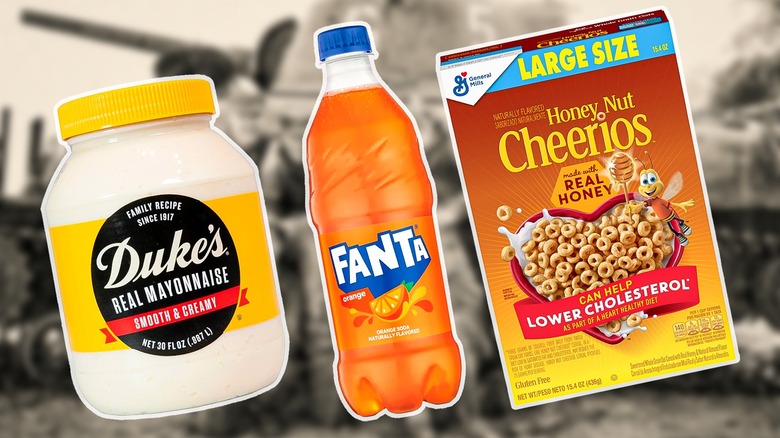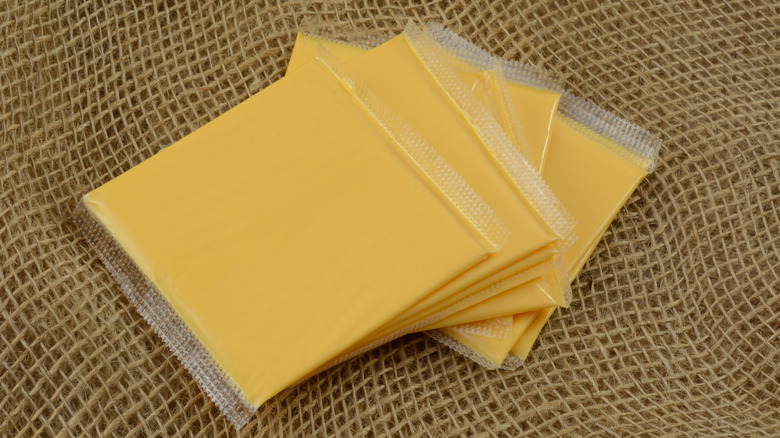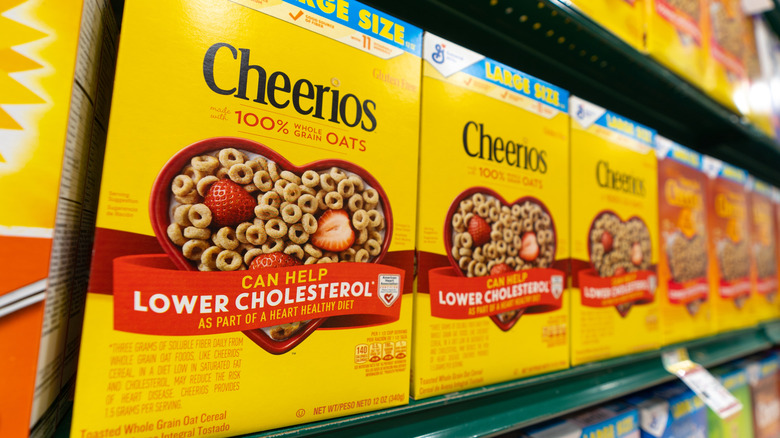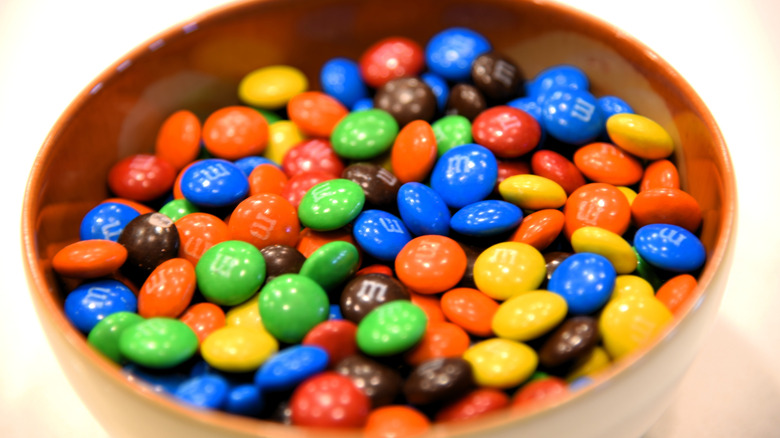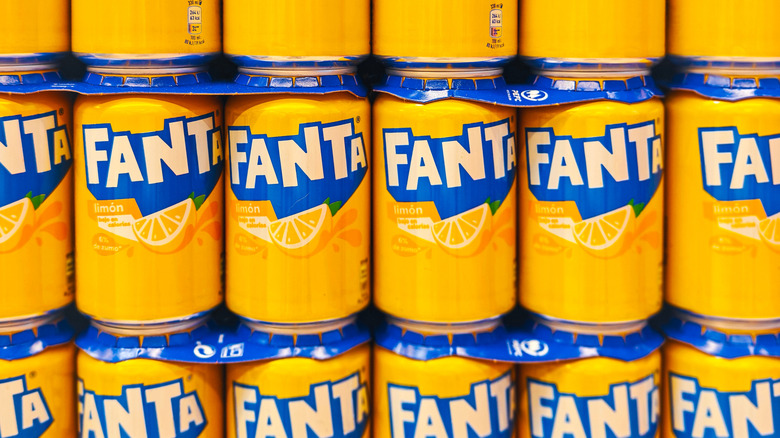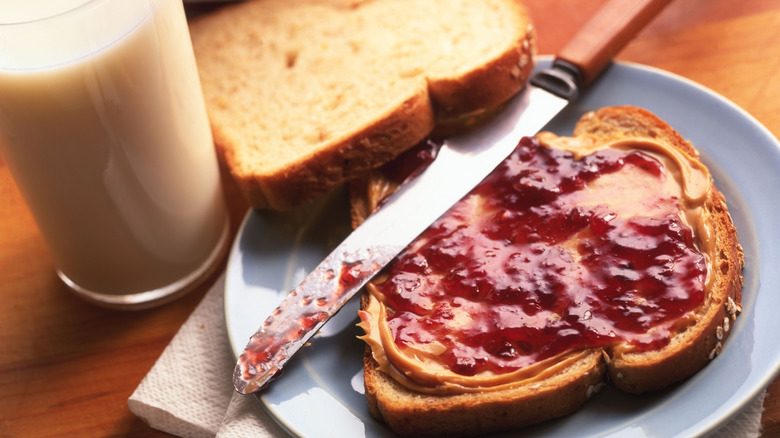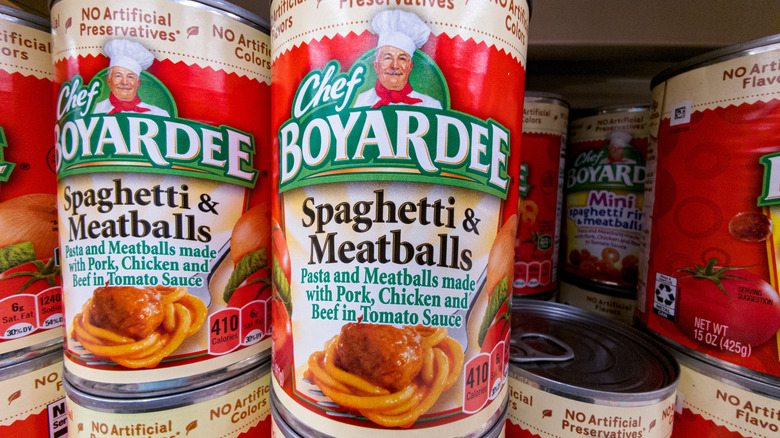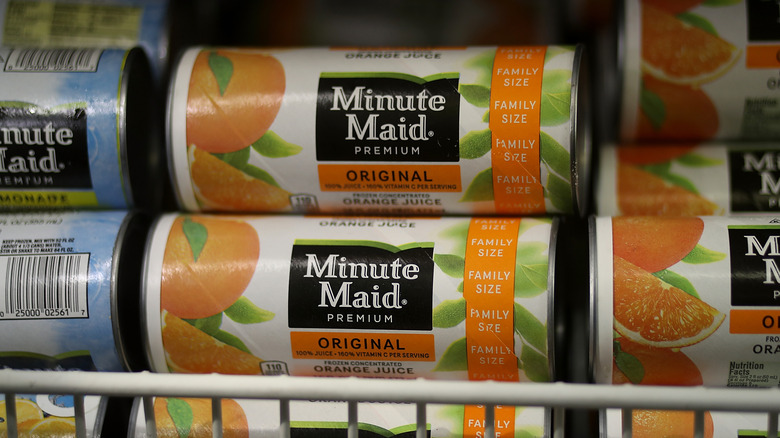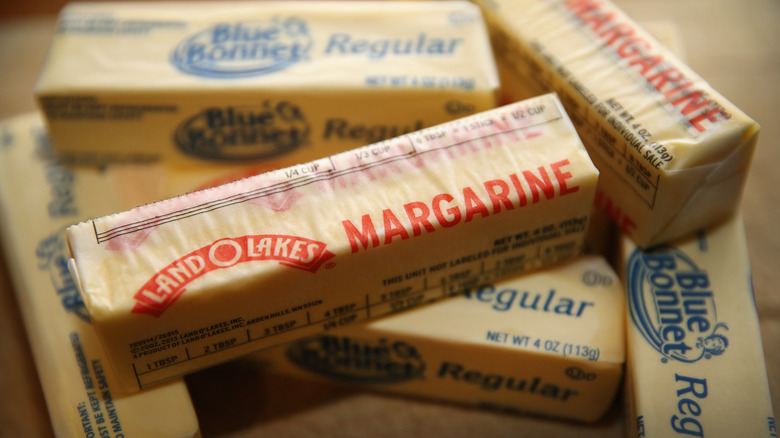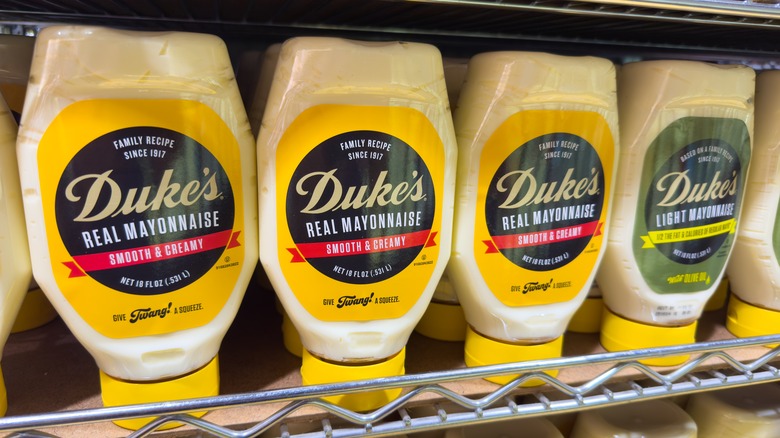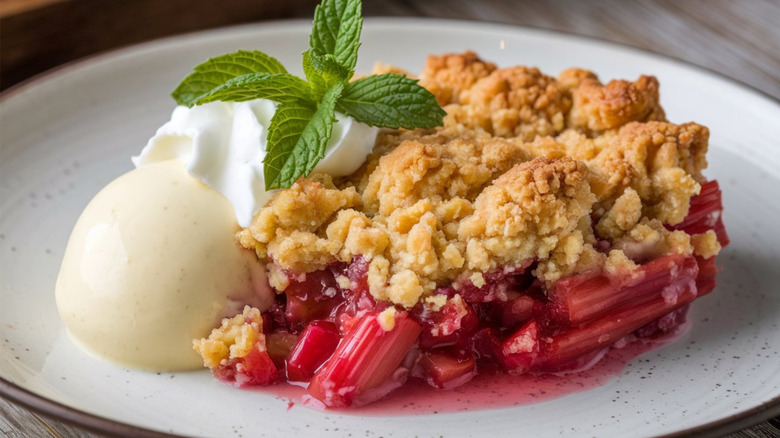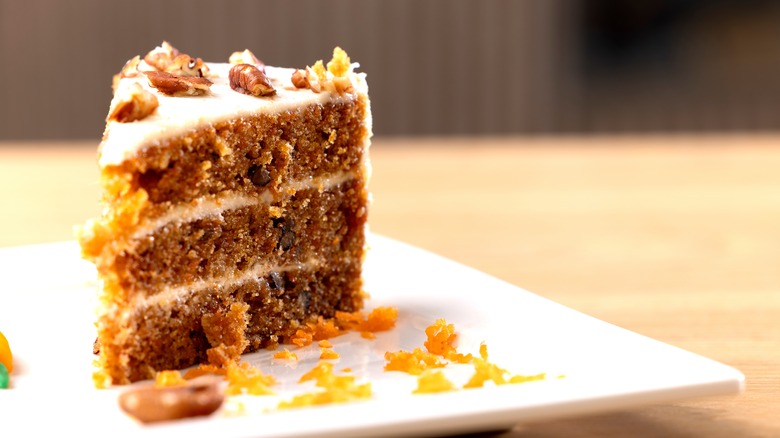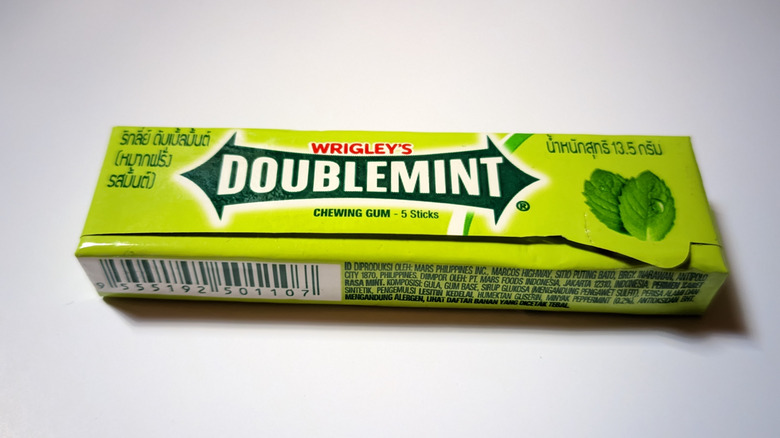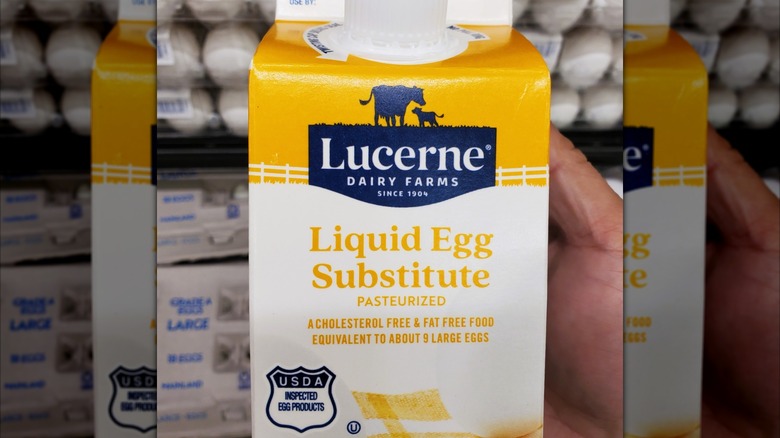16 Vintage Foods Popularized During Wartime That We Still Eat Today
Wartime — particularly the two World Wars — changed so much about how we live, for better or for worse. One overlooked part of your life that is the way it is because of this period in time? Your pantry.
The World Wars gave birth to a wealth of new food inventions and products, due to a variety of reasons. During wartime, some ingredients became scarce. As food was shipped out to the frontlines, the folks back home were forced to reimagine their meals, using whatever ingredients they might have on hand. In some instances, food scientists rolled up their sleeves in the express interest of crafting food that would last longer and provide more nutrients on the battlefield. In other cases, food from international cuisines was either embraced or eschewed, depending on which side of a war you were on.
We've these reasons and more to thank for some of the foods that we enjoy today, from M&Ms to breakfast cereals and beyond. Here are 16 foods popularized during wartime that we still eat every day.
Spam
Okay, even if you don't eat Spam every day, there's no denying that it has found its niche of loyal consumers. Through the late 2010s and early 2020s, Spam sold in record quantities, each year bypassing the last, as the processed meat made its way into headlines, onto menus, and into viral TikTok posts.
While Spam wasn't invented during any war (it was invented in 1937, in Minnesota), it saw a boom in popularity during World War II as the U.S. military included Spam in its military rations. It's estimated that the military required as much as 100 million pounds of the stuff over the course of the war. During this time, those individuals stationed in the Pacific Theater would share their rationed Spam with both locals and those rescued from incarceration camps, and those actions further cemented Spam as a tasty ingredient in Hawaiian cuisine. The state leads the United States in Spam consumption.
Processed cheese
While just the words "processed cheese" don't exactly sound too appetizing, most of us have a guilty pleasure snack that requires this ingredient. Think nostalgically neon-orange Kraft macaroni and cheese, or the dust on your Cheetos, or even the slices of processed cheese that really make a simple grilled cheese sandwich what it is.
Just as was the case with Spam, the U.S. military helped the processed cheese industry find its feet, when it called upon Kraft, wanting to buy up to 6 million pounds of Kraft's processed cheese for its World War I rations. This early processed cheese was somewhat similar to Kraft Singles, though it wasn't packaged in single slices. Instead, it came in a tin and was white rather than yellow-orange. By World War II, the demand for processed cheese had grown so much that the U.S. Army bought, in just one year, more than 100 million pounds of it. Additionally, military-funded research was looking for ways to dehydrate food, to make for easier shipping to troops. Cheese powders like the ones you find on your Cheetos or in a box of Kraft macaroni and cheese were the ultimate result.
Cheerios
Prior to the 1940s, there were no ready-to-eat breakfast cereals on grocery store shelves made predominantly from oats. Cheerioats, the predecessor to Cheerios and which debuted in 1941, changed all that. After much research and trial and error, General Mills managed to create a ready-to-eat, oat-based breakfast cereal. While this product wasn't a wartime necessity to feed the troops, it was widely popular with the folks back home, due to its convenience and the manner in which General Mills marketed it as a nutritious time-saver to families who were potentially a bit busier and more stressed thanks to the state of the world. Additionally, General Mills went all in with Uncle Sam-centric advertising.
So how did Cheerioats become Cheerios? Quaker Oats accused General Mills of creating a product with too similar a name and, in 1945, General Mills changed the cereal's branding to simply Cheerios. By the 1950s, Cheerios had become a top-selling cereal.
M&Ms
M&Ms burst onto the candy scene during World War II, but their story goes back a little further than that, to another war. During the Spanish Civil War, Forrest Mars Sr. came upon the discovery that, if you encased chocolate in hard sugar, you'd be able to carry that chocolate around with you, without it melting the way the average chocolate bar might. At that time, soldiers fighting in the Spanish Civil War were eating a very early iteration of what Mars would turn into his landmark candy.
Fast-forward a decade later, Mars partnered with Hershey, got a patent, and began producing M&Ms, selling them to the U.S. military for inclusion in World War II ration kits. The public couldn't get their hands on M&Ms until the war ended, but then folks began to gobble them up, including American soldiers who'd returned home craving this favorite ration inclusion.
M&Ms continued to make history, as the first candy to go into space. The candy traveled on the space shuttle Columbia in 1981.
Fanta
Prior to World War II, Fanta-maker Coca-Cola had grown to the point that it had expanded its operations to encompass bottling plants in Europe, including one in Germany — and up until the United States entered the war, Coca-Cola turned a blind eye to the Nazi Party's actions, continuing on with its German business as if nothing were awry. Coca-Cola sponsored the 1936 Berlin Olympics. The Coca-Cola logo appeared next to the swastika on banners at the event. High-up Nazi leaders, including Hitler, were supposed to love Coca-Cola.
However, after the United States entered the war, the Coca-Cola headquarters in the States was forced to cease supporting its German branch. The bottling plant could no longer make Coke and so its German leaders decided to make their own soda. Using a mishmash of ingredients that could be cobbled together given the day's rations, they put together a concoction made from fruit shavings, apple fibers, beet sugar, and whey, and called it Fanta. After the war, Coca-Cola's headquarters resumed its work in Europe and, in 1955, a Fanta with a new orange-based recipe was introduced.
PB&J
Some claim that we can thank the troops for PB&J's widespread, modern-day popularity. However, we can't thank them for the sandwich's invention. That honor goes to The Boston Cooking School magazine, which published a peanut butter and currant jelly finger sandwich recipe in 1901.
By the 1920s, families were eating peanut butter and jelly sandwiches for their convenience, affordability, and nutrients. But the sandwiches may've not looked quite the same as the PB&Js of your youth, in part because grape jelly wasn't really a thing until 1917, when Welch's grape jelly premiered — and in the late days of World War I, soldiers took to that grape jelly with gusto. Their ration kits contained bread, peanut butter, and the Welch's grape jelly, and they combined them all together to create a PB&J that's more familiar to modern consumers.
By the time the next World War rolled around, the classic peanut butter and jelly was on the ration menu for U.S. troops, and peanut butter continued to find its place in rations throughout the Korean War and Vietnam War.
Chef Boyardee
The real Chef Boyardee was Chef Hector Boiardi, a successful Italian chef who worked in New York City before opening his own restaurant in Cleveland. There, his food became so popular that he began bottling and selling his pasta sauce, under the Chef Boyardee brand (named such so as to help the Americans out with the pronunciation). During World War II, the U.S. military caught wind of Chef Boyardee's work and commissioned Boiardi to can his restaurant's food for easy inclusion in the military rations. Chef Boyardee quickly became one of the largest food suppliers for World War II rations and, by 1942, Boiardi was keeping his plant open 24 hours a day, every day, so as to meet demand.
Boiardi was later given The Gold Star, a military honor reserved for civilians. Chef Boyardee was still a part of military rations as of the first Gulf War in the 1990s.
Frozen orange juice
Frozen orange juice definitely existed before World War II — but it wasn't anything to write home about. For unknown reasons, as of the 1930s, the same processes used to freeze and then ship apple and tomato juice around the country just didn't work for orange juice. While you could freeze and ship orange juice to states beyond the reach of citrus-growing regions, you didn't really want to, because by the time it arrived and thawed, it had deteriorated in every way.
However, government scientists were determined to fix this issue once World War II started up and the troops needed their Vitamin C. In 1945, a group of them from the U.S. Department of Agriculture successfully fine-tuned the process, patented it, and then released the process details to the public, where enterprising individuals scooped them up and got to work. The military ordered a massive supply of frozen orange juice concentrate from a private provider — and then the war ended. The company working on the large order pivoted, started selling frozen orange juice to the public, and christened its product Minute Maid.
Instant coffee
The first record of successfully mass producing instant coffee can be traced to the 1910s, when an immigrant by the name of George Washington began producing instant coffee in Brooklyn, marketing it as an easier-on-your-digestive-system alternative to regular coffee. Competitors soon realized what Washington had on his hands and followed suit, but it was Washington's OG instant coffee that became popular with the troops, with the military demanding nearly 40,000 pounds of instant coffee per day.
Instant coffee, though, packaged in its little envelopes, wasn't just convenient on the front lines. It was a necessity for anyone who wanted their daily cup of Joe as, due to the new use of chemical weapons in warfare, brewing coffee the old-fashioned way, out in the open, was impossible.
After the war, George Washington began selling his instant coffee to consumers, proudly touting the brand's role in the war. Soon, though, Nescafe introduced its instant coffee, which quickly overtook the market, putting George Washington's coffee company out of business by the 1960s.
Margarine
Margarine has been an affordable alternative to butter since its invention in the 1860s, but it really only took off in the United States in World War II. Prior to this, the American dairy industry had lobbied against margarine, with even some federal and state laws passed that prohibited margarine sales or otherwise made those sales very difficult. In 1932, 27 states had laws against selling yellow margarine, stating that dying margarine yellow "tricked" consumers into thinking they were getting something like butter. (To get around this, margarine makers would package the yellow dye separately and instruct buyers to combine the coloring with the white margarine at home, for a more appealing appearance.)
However, it was the shortages and rations during World War II, limiting the amount of available butter, that prompted home cooks to look for something to use in its stead on a larger scale. With butter more or less taken out of the competition, all the bad-mouthing against margarine stopped and the sales bans and weird laws dropped. By 1967, all states permitted the sale of yellow margarine.
Duke's Mayonnaise
Duke's mayonnaise is now a staple in the South and beyond, and its roots are planted in feeding the troops. However, unlike Chef Boyardee, Duke's wasn't shipping off jars of mayonnaise to the frontlines. Instead, Duke's founder Eugenia Duke started her mayonnaise empire by simply making sandwiches — featuring her homemade mayo, of course — and selling them at the army canteen nearby where she lived in South Carolina during World War I. The sandwiches, which included Southern favorites like egg salad and pimento cheese, were so popular that she needed a delivery truck, and then she eventually started a restaurant, too.
Eugenia's sandwiches, but more importantly the mayonnaise, made quite an impact on the soldiers stationed at Camp Sevier in the 1910s, as years later they would mail her letters asking for her to send them recipes or even just a jar of mayonnaise according to the company's website. So, in 1923, Eugenia switched from the sandwich and restaurant business to focusing on bottling her mayonnaise. By 1929, Eugenia's business had grown so much that she sold it.
Fruit crumbles
Who doesn't love a good pie? It's just the comfort food you'd want during a trying time. Unfortunately, during World War II, the various rations at play made making a true pie a little out of the question. There wasn't enough butter to make a good pie crust. Flour and sugar weren't exactly available in large quantities either. Enter, the British wartime invention of the fruit crumble.
A crumble could be made with whatever seasonal fruit you had on hand, and home cooks relied on that fruit to provide the crumble's sweetness. The crumbly bits on top required far less butter, sugar, and flour than your standard pie crust. You could also use oats to supplement the flour, and lard instead of butter. Over time, crumbles have evolved to include ingredients that are readily available, like shredded coconut and more sugar, but during a war, they managed to provide just a little taste of comfort with what minimal ingredients a home cook had.
Carrot cake
Carrot cake was one of the handful of dishes heavily featured in British World War II propaganda, alongside a slew of other carrot-containing recipes, both sweet and savory. There were a few reasons why the Brits got big on carrots during this time period.
For one, carrots were never rationed, as was the case with all vegetables. You could grow carrots in England and eat as many of them as you liked, without impacting food shortages. Secondly, carrots were being encouraged for use as a sugar substitute. (While it is true that carrots can be used, just like sweet potatoes, in sugar-free recipes to add a bit of sweetness, though, don't go thinking you can arrive at anything close to a true cake by using just the humble carrot alone.)
Then, there was the fact that the Brits had a big rumor going that, the reason for the Royal Air Force's newfound success, was simply carrots. Their pilots ate a lot of carrots and that improved their eyesight considerably, to the point that it helped turn the tide of the war. In reality, the Royal Air Force had just adopted a new technology: aircraft interception radar.
Chewing gum
Chewing gum is hardly an invention of the modern era, but its popularity with soldiers during the World Wars certainly helped finalize its place in the candy aisle. Over the first half of the 20th century, chewing gum served multiple functions for soldiers. In some instances, it was used as a drug substitute, providing psychological stimulation. In other cases, it was used as a morale booster, and some thought that the act of chewing gum could calm frayed nerves in the midst of combat. At its simplest, though, chewing gum could induce saliva, meaning that the military didn't have to worry about getting quite so much fresh water to thirsty soldiers on the front line, quite so quickly. Additionally, that saliva production helped to keep teeth clean in unsanitary conditions.
Today, soldiers are still issued chewing gum in their combat rations. The military wracks up a $600,000 chewing gum bill per year, which covers about 72 million pieces of gum.
Egg substitutes
You might turn up your nose at the idea of using an egg substitute today, but they were commonplace during World War II. While scientists worked on dehydrating ingredients for easier transport to troops, and while they were laying the foundation for powdered cheese while they were at it, they already had access to dehydrated eggs, which can be traced back to the 1800s. However, in the 1930s, the dehydration process had improved considerably and, during World War II, the British shared their patented, superior dehydration process with the Americans, allowing for production to increase significantly. During World War II, about 25% of all of the United States' eggs were dehydrated and then sent off to its Allies.
Unfortunately, even with better egg dehydration processes discovered, the end process wasn't exactly praised by the average consumer. Once reconstituted, the dried eggs weren't great to eat on their own and not ideal for baking. They most often ended up being used as fillers in broader recipes, or they were served at institutions where diners didn't have a choice but to tuck in.
